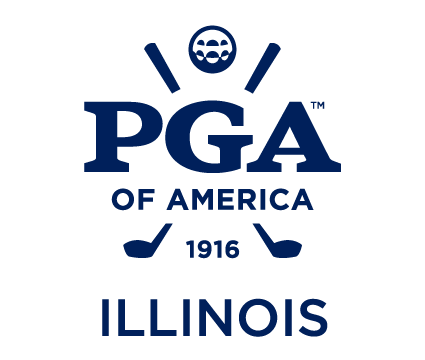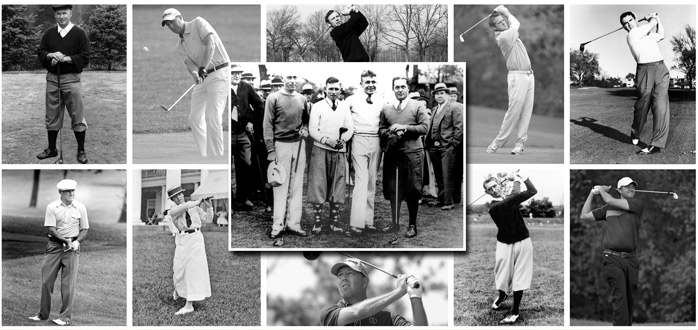Robert White isn’t exactly a household name in golf these days.
In his time, he was an invaluable leader.
Without White’s experience, much of it gained in a long stint in the Chicago area, the Professional Golfers’ Association of America – the PGA, this year celebrating its centennial – might not have been established until well after 1916. And without the PGA’s national formation, there is no Middle States Section, headquartered in Chicago and covering a swath of the continent from Key West to Toronto. Renamed the Illinois Section late in 1921, it celebrates its centennial concurrently with the national body.
White, the first president of the PGA, is mentioned in the history of the group, but generally only in passing. The same is true for Alex Pirie, another with Chicago ties who was the PGA’s fourth president. Rodman Wanamaker, whose prodding and offer of prize money and a trophy for an annual championship was a considerable motivator, rightly gets a nod. So do pros like Jack Hobens and Gil Nicholls, who were in on the formation meetings.
White and Pirie, there at the start, deserve a brighter spotlight.
They wanted on a national basis what had already been accomplished on a regional scale. White had previously been president of the Western Professional Golfers Association. The WPGA had been formed in 1899 and by 1905 was held in high enough regard that its championship was held at Chicago Golf Club. (Rockford’s Fred McLeod beat Cleveland’s Bertie Way in the 36-hole final match.)
The professional at Ravisloe from 1903 to 1913, White wasn’t a great player, but he was an innovative businessman. Schooled in St. Andrews and apprenticed to Old Tom Morris for four years while also teaching school, White was the first to bring fellow pros together to sell clubs nationally, making them in the winter and selling in the spring. When course management was often part of the portfolio, White was also an early leader in agronomy, the fine art of making courses playable in an era when the power lawn mower was new and chemicals to treat diseased turf were in their infancy.
When White left for Shawnee, Pa. – he was at Wykagyl Country Club in New York when the first PGA meetings were held early in 1916 – he was regarded among America’s foremost professionals, and the logical first president of the PGA of America.
Alexander “Alec” Newton Pirie came from an equally golf-rich background. His father worked with Allan Robertson, the first recognized professional, at St. Andrews. Like White, he was deeply involved in the formation of the national PGA. After stays in the east and south, Alec arrived in Chicago and by 1921 was the head professional at Old Elm. By late in 1922, he was elected president of the renamed Illinois Section. Four years after that, he was elected president of the national body.
Pirie, like White, was a businessman of the first order. That impressed club members and outsiders alike, many of whom had previously regarded the golf pro as an old Scot with a gruff facade who fancied a drink after 3 p.m., if not before.
Wrote the AP’s Basil Wyrick in 1930, when Pirie’s term was ending, “Now the professional has the same standing with his clients, golf pupils and purchasers of golf supplies, as has any other merchandiser of knowledge or of goods. His opinion is sought on virtually all subjects by officers of the club, and his social status is equal to that of any member.”
The PGA’s formation triggered similar organizational work in each section. Originally, there were to be 12, including three in Canada, but by the time the map was drawn in ink at the inaugural annual meeting, held in Minneapolis on June 26-27 during the 1916 U.S. Open, there were seven sections: Middle States, Metropolitan, New England, Central, Southeastern, Western and Pacific. Of the 41 sections today, the Metropolitan (a.k.a. New York and suburbs) is closest to its original boundaries, though even there, New Jersey broke away. And only the Met and New England sections retain their original names.
Middle States is not to be confused with the more common term Midwest. Middle States was already in use in tennis and sailing, so the PGA was moving on familiar ground in 1916. Midwest would have been a misnomer anyway, for along with Illinois and a large swath of Ontario, the Middle States Section included Michigan, Indiana, Ohio, Pennsylvania, Kentucky, Tennessee, Alabama, Louisiana and Florida.
Geographic diversity aside, the Middle States organizing committee was exclusively populated by prominent Chicago professionals:
• Jack Croke: head professional at Exmoor Country Club, who would later head Cook County’s Forest Preserve golf operations;
• George Fotheringham: in 1916 the new professional at Indian Hill Club, and the secretary of the national PGA;
• Walter Fovargue: for 10 years the head professional at Skokie Country Club;
• Stewart Gardner: head professional at Old Elm between stints before and after Croke at Exmoor.
• William Marshall: the esteemed head professional at Onwentsia Club, whose death in March of 1922 caused section officials to name the trophy for the reconstituted Illinois Section Championship after him;
• and David McIntosh: the professional at Glen Oak Country Club, previously at Westward Ho, and a course designer of some note, including the front nine at Ridgemoor and the first two original courses at Cog Hill.
The group selected Fovargue the Middle States Section secretary, the man in charge of section affairs. He would hold that post only until the end of the year, when he left to represent a manufacturer on the west coast and also consult for architect Donald Ross.
In 1916, the only section-sanctioned competition was the Middle States Section Championship, which was held to determine the seven qualifiers for the 32-man field of the inaugural PGA Championship.
September 18 was the big day. The field, reported by the Chicago Tribune and other outlets as 22, mostly from the immediate Chicago area, teed it up across 36 holes at the Glen View Club. Oak Park Country Club’s George Simpson scored 3-under-par 71 in the morning to take a six-stroke lead on Robert McNulty and coasted to a victory of that margin over McNulty and Fotheringham with a total of 1-under-par 147.
That trio, plus J.J. O’Brien of Mansfield, Ohio, Jimmy Donaldson of Glen View, Fovargue and Cyril Walker of Wabash, Ind., qualified for the first PGA, held at Siwanoy Country Club near New York. Jack Burke of Rockford, father of 1956 PGA champion Jackie Burke, failed to advance.
Simpson, O’Brien and Walker won their first-round matches at Siwanoy. O’Brien knocked off Simpson in the Round of 16, while both O’Brien and Walker lost in the quarterfinals.
The Middle States would not produce a PGA champion until 1920, when Jock Hutchison, in his third year as professional at Glen View and a last-minute entry as an alternate, captured the PGA held at Flossmoor Country Club. By the time Evanston standout Johnny Revolta won the 1935 PGA, the section was deep into the Illinois years.
The big realignment, late in 1921, turned the original seven sections into 25 smaller units to eliminate festering complaints of poor representation. The size of the sections may have accounted for the PGA’s decision to use that year’s U.S. Open, rather than section qualifying, to select the field which would challenge Hutchison for the 1921 PGA title. (With no PGA in 1917 and 1918, there was also no known section competition.)
The three known Middle States PGA Championships were all held in the Chicago area. The field in 1916 featured players from only four of 10 states, and nobody from Ontario or south of the Mason-Dixon Line. Similar area domination occurred in 1919, when Evanston’s Bob MacDonald won at Oak Park, and 1920, when Evanston’s Laurie Ayton won at Westmoreland.
The reorganization, which included six new sections from Middle States – itself renamed Illinois – would mean a more representative field in the PGA, and more tournaments in each section, including Illinois. Thus debuted in 1922 the Illinois PGA Section Championship, played at Westmoreland Country Club – 36 holes in one day, the day after a best-ball pro-am. Eddie Loos, the head professional at Lake Shore Country Club, scored 73-72 for 1-over-par 145 to edge Hutchison, a four-time major champion, by a stroke. Ayton, effectively the defending champion, was third.
With that, the renamed and refocused Illinois PGA Section, seven years old, was off and running.

